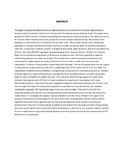| dc.description.abstract | This paper analyses the determinants of capital structure for private firms in Kenya. Past literature focuses mainly on publicly listed firms in Kenya with the samples being relatively small. This paper has a sample of 1292 firms from all sectors excluding the financial and insurance sectors. The capital structure for firms in these industries are quite unique due to their unique business model. We exclude them because in most literature in this field do not consider them.
We consider eleven main variables as discussed in the past theoretical literature namely non-debt tax shields, debt tax shields, profitability, cash flow, uniqueness, volatility, growth, managerial ownership, asset structure, size and manufacturing dummy. We used ANCOVA regression analysis because there was one dummy variable, the industry. Eight of the variables are significant at 95 percent confidence level. We find a significant negative relationship between non-debt tax shields.
This implies that investments credits arising from the investments in capital assets are a big incentive for a finn to take on debt and contrary to the expectation in theory it has a positive relationship with leverage. This can be explained by the tax regime in Kenya where investments tax credit form a significant part of the incentives for firms to invest. The insignificant variables were profitability, managerial ownership and the manufacturing dummy.
Notable findings regard the relationship between leverage and three variables namely; non-debt tax shields, asset structure (tangibility of assets) and size. The most surprising findings regard the relationship between leverage and size of finn, for these variables the results were inconsistent with most theoretical literature. Theoretical literature suggests a negative relationship between size of a finn and the leverage, that larger firms should be expected to use debt more conservatively.
Our analysis revealed the opposite. We found that larger firms rely more on debt. This is not in line with the empirical studies covering the more developed economies and underlines the critical role that policy makers have in 'increasing the access of capital available to smaller firms. Smaller firms, apart from facing the constraints of raising capital internally, find it hard to access debt markets.
Policy makers especially the government agencies such as Industrial development bank and the multinational development a big role of making capital available to the smaller firms through provision of guarantees and even hybrid capital instruments like preferential equity on soft terms, It is critical to support smaller firms to enable them to grow and thereby support economic growth as well as the improvement of the welfare of the households. | en_US |

